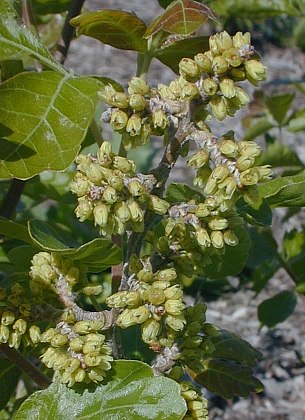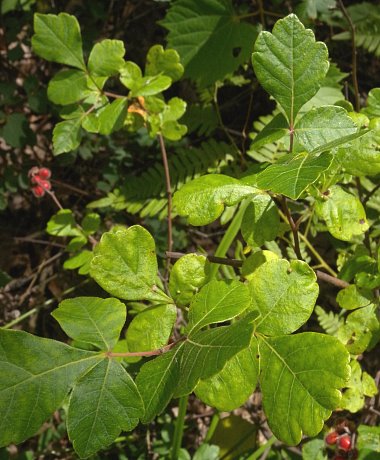Description: This woody shrub is 2-8' tall. Depending on the variety, it is variable in size and branching habit. Fragrant Sumac can be an erect shrub with ascending branches, or it can be a low shrub with spreading branches. The trunk and lower branches are greyish brown and woody, while the upper branches are more or less pubescent. The alternate leaves are trifoliate. The individual leaflets are up to 3" long and 1½" across, although they are often half this size. The terminal leaflet is somewhat larger than the lateral leaflets. They are elliptic, oval-ovate, oblanceolate, or obovate in shape, coarsely crenate or shallowly cleft along their margins, and green, yellowish green, or red. The upper surface of each leaflet is glabrous to finely pubescent (canescent), while the lower surface is sparsely pubescent to softly hairy. Each leaflet is sessile, or it has a short petiole. The crushed foliage has a pleasant bittersweet fragrance. Occasionally, short spikes of flowers or panicles of floral spikes are produced from the axils of the leaves. These flowers can appear before or during the early development of the leaves. Each floral spike is up to 1" long. The individual flowers are greenish yellow, short-tubular in shape, and about 1/8" long; they can be perfect or unisexual (male or female).

The
blooming period occurs during mid-spring for 1-2 weeks. During the summer, the
flowers are replaced by hairy drupes that become red at maturity. Each drupe is up to ¼" across
and globoid-ovoid in shape; it contains a single stone (seed with a
hard coat). The root system is long-rhizomatous, often forming clonal colonies of this shrub.
Cultivation:
The preference is full or partial sun, dry conditions, and soil that is
sandy or rocky. However, this shrub will adapt to mesic conditions with
fertile loamy soil if there is not too much competition from other
species of plants.
Range & Habitat:
The native Aromatic Sumac is occasional in parts of southern, western,
and
northern Illinois; it is uncommon or absent from east central Illinois
(see Distribution
Map). This map combines the distribution of the different
varieties of Aromatic Sumac. Aromatic Sumac is more tree-like and erect
in southern Illinois, but a low spreading shrub elsewhere in the state.
Habitats include thinly wooded bluffs, upland rocky woods, barren rocky
areas, limestone glades, sandy savannas, sand prairies, and sand dunes.
Aromatic Sumac is often cultivated as an ornamental shrub in yards or
along buildings and city streets.

Faunal
Associations:
The nectar and/or pollen of the flowers attract primarily Halictid bees
(including green metallic bees), Andrenine bees, cuckoo bees (Nomada
spp.), Syrphid flies, and other miscellaneous flies (Robertson, 1929).
Small carpenter bees (Ceratina spp.) burrow into the pith of stems of
sumacs to build their nests and lay eggs. Insects that feed
destructively on the leaves, woody stems, and other parts of sumacs
(Rhus spp.) include the larvae of long-horned beetles, larvae of gall
flies, plant bugs, stink bugs, aphids, treehoppers, larvae of Geometer
moths, larvae of owlet moths, and larvae of prominent moths. In
addition, the larvae of two butterflies, the Red-banded Hairstreak
(Calycopis cecrops) and Spring Azure (Celastrina ladon), also feed on
these shrubs. See the Insect Table
for more information about these and other species. The hairy red
drupes of sumac (Rhus spp.) are largely used as emergency food by birds
during migration or winter when little else is available. Nonetheless,
a large number of bird species have been observed eating these drupes,
including songbirds, upland gamebirds, and woodpeckers (see Bird Table
for a listing of these species). Some mammals use sumac as a source of
food. For example, the American Moose and White-tailed Deer browse on
the foliage and twigs, while the Cottontail Rabbit gnaws on the bark
during winter (Martin et al., 1951/1961).

Photographic
Location:
The floral spikes were photographed along a city street in Champaign,
Illinois. The trifoliate leaves and hairy red drupes were photographed
on a stabilized sand dune near Lake Michigan at the Indiana Dunes State
Park in NW Indiana.
Comments:
Fragrant Sumac is smaller and less aggressive than Rhus glabra
(Smooth Sumac) and Rhus typhina (Staghorn Sumac).
The flowers of Fragrant Sumac bloom earlier in the spring and its
drupes ripen earlier in the summer than these other species. Its
compound leaves are trifoliate, while the odd-pinnate leaves of other
Sumacs in Illinois have many more leaflets than this. These other
Sumacs also lack the aromatic foliage of Fragrant Sumac.